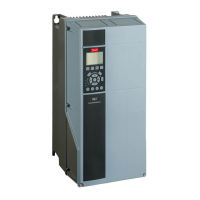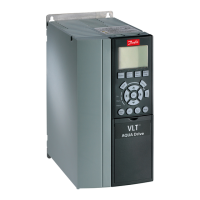3.9 Parameters: 7-** Controllers
3.9.1 7-0* Speed PID Ctrl.
7-00 Speed PID Feedback Source
Option: Function:
Select the encoder for closed-loop
feedback.
The feedback may come from a
different encoder (typically mounted
on the application itself) than the
motor mounted encoder feedback
selected in 1-02 Flux Motor Feedback
Source.
[0] * Motor feedb. P1-02
[1] 24V encoder
[2] MCB 102
[3] MCB 103
[4] MCO Encoder 1 X56
[5] MCO Encoder 2 X55
[6] Analog input 53
[7] Analog input 54
[8] Frequency input 29
[9] Frequency input 33
NOTE!
This parameter cannot be adjusted while the motor is
running.
NOTE!
If separate encoders are used (FC 302 only), the ramp
settings parameters in the following groups: 3-4*, 3-5*,
3-6*, 3-7* and 3-8* must be adjusted according to the gear
ratio between the two encoders.
7-02 Speed PID Proportional Gain
Range: Function:
Application
dependent*
[0.000 -
1.000 ]
Enter the speed controller proportional
gain. The proportional gain amplifies
the error (i.e., the deviation between
the feedback signal and the setpoint).
This parameter is used with 1-00 Config-
uration Mode Speed open-loop [0] and
Speed closed-loop [1] control. Quick
control is obtained at high amplifi-
cation. However, if the amplification is
too great, the process may become
unstable.
Use this parameter for values with
three decimals. For a selection with
four decimals, use 3-83 Quick Stop S-
ramp Ratio at Decel. Start.
7-02 Speed PID Proportional Gain
Range: Function:
0 N/A* [0.000 -
1.000
N/A]
Enter the speed controller proportional
gain. The proportional gain amplifies
the error (i.e., the deviation between
the feedback signal and the setpoint).
This parameter is used with 1-00 Config-
uration Mode Speed open-loop [0] and
Speed closed-loop [1] control. Quick
control is obtained at high amplifi-
cation. However, if the amplification is
too great, the process may become
unstable.
If the selection is xxx.xxx, use this
parameter. If the selection is xxx.xxxx,
use 3-83 Quick Stop S-ramp Ratio at
Decel. Start.
7-03 Speed PID Integral Time
Range: Function:
Application
dependent*
[2.0 -
20000.0
ms]
Application
dependent*
[2.0 -
20000.0
ms]
Enter the speed controller integral
time, which determines the time the
internal PID control takes to correct
errors. The greater the error, the
more quickly the gain increases. The
integral time causes a delay of the
signal and therefore a damping
effect, and can be used to eliminate
steady state speed error. Obtain quick
control through a short integral time,
though if the integral time is too
short, the process becomes unstable.
An excessively long integral time
disables the integral action, leading
to major deviations from the required
reference, since the process regulator
takes too long to regulate errors. This
parameter is used with Speed open-
loop [0] and Speed closed-loop [1]
control, set in 1-00 Configuration
Mode.
7-04 Speed PID Differentiation Time
Range: Function:
Application
dependent*
[0.0 -
200.0
ms]
Enter the speed controller differentiation
time. The differentiator does not react to
constant error. It provides gain propor-
tional to the rate of change of the speed
feedback. The quicker the error changes,
the stronger the gain from the differen-
Parameter Descriptions FC 300 Programming Guide
3-78 MG33MD22 - VLT
®
is a registered Danfoss trademark
3
3

